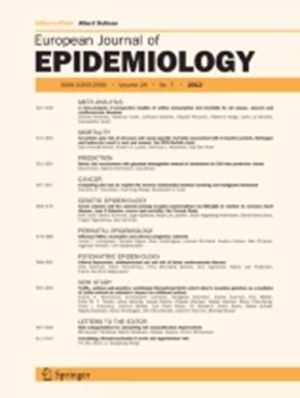Fetal programming of early-onset type 2 diabetes: a Swedish nationwide cohort and sibling analysis.
IF 5.9
1区 医学
Q1 PUBLIC, ENVIRONMENTAL & OCCUPATIONAL HEALTH
引用次数: 0
Abstract
Incidence of early-onset (< 40 years) type 2 diabetes (T2D) is increasing. While multiple risk factors have been identified, particularly obesity and low socioeconomic status, early-life factors are hypothesised to play a role via fetal programming. We investigated sociodemographic and early-life factors in relation to early-onset T2D using a family-based design that accounts for shared genetic and environmental factors. We included 1,814,062 individuals born in Sweden 1983 to 2002 with follow-up data until 2020, and identified early-onset (age 19-39) T2D cases (n = 3505) through National Diabetes, Patient and Prescribed Drug Registers. Perinatal and sociodemographic factors were retrieved from registers. We used a cohort and sibling design, with multivariable-adjusted Cox proportional hazards regression. Sociodemographic factors associated with early-onset T2D included low parental education, single parenthood, younger parental age and non-Swedish origin. The latter association did not remain after mutual adjustment. Regarding perinatal factors, a higher incidence was noted in relation to lower birth weight (hazard ratio 2.38 [95% confidence interval: 1.98-2.87] and 1.43[1.33-1.54] for < 2500 g and 2500-3500 g, respectively, vs 3500-4500 g), small-for-gestational-age (SGA) (2.24[1.96-2.56]), large-for-gestational-age (LGA) (1.19[1.01-1.39]), and maternal obesity (2.34[2.04-2.69]), diabetes (1.59[1.36-1.85]), smoking (1.59[1.48-1.71]), and infection (1.21[1.03-1.41]) during pregnancy. In the sibling analysis, only low birth weight and SGA remained associated with early-onset T2D. Early-onset T2D is associated with sociodemographic and multiple perinatal factors; only growth restriction likely reflects fetal programming, while other perinatal-related associations might involve confounders. This study highlights the need for early-life, targeted strategies to prevent T2D and reduce health inequities.早发型2型糖尿病的胎儿规划:瑞典全国队列和兄弟姐妹分析。
早发性(< 40岁)2型糖尿病(T2D)的发病率正在上升。虽然已经确定了多种风险因素,特别是肥胖和低社会经济地位,但假设早期生活因素通过胎儿编程发挥作用。我们研究了与早发性T2D相关的社会人口学和早期生活因素,采用基于家庭的设计,考虑了共同的遗传和环境因素。我们纳入了1983年至2002年在瑞典出生的1,814,062人,随访数据至2020年,并通过国家糖尿病、患者和处方药登记处确定了早发性(19-39岁)T2D病例(n = 3505)。从登记册中检索围产期和社会人口因素。我们采用队列和同胞设计,采用多变量校正Cox比例风险回归。与早发性T2D相关的社会人口因素包括父母受教育程度低、单亲、父母年龄较小和非瑞典血统。后一种联系在相互调整后没有保留。发现关于围产期因素,发病率高与低出生体重(风险比2.38(95%置信区间:1.98 - -2.87)和1.43(1.33 - -1.54)< 2500克和2500 - 3500克,分别与3500 - 4500 g), small-for-gestational-age (SGA)(2.24[1.96—-2.56]),large-for-gestational-age (LGA)(1.19[1.01—-1.39]),和母亲肥胖(2.34[2.04—-2.69])、糖尿病(1.59[1.36—-1.85]),吸烟(1.59[1.48—-1.71]),和感染在怀孕期间(1.21[1.03—-1.41])。在兄弟姐妹分析中,只有低出生体重和SGA仍然与早发性T2D有关。早发性T2D与社会人口学和多种围产期因素有关;只有生长受限可能反映了胎儿计划,而其他围产期相关的关联可能涉及混杂因素。这项研究强调需要在生命早期制定有针对性的策略来预防糖尿病和减少健康不平等。
本文章由计算机程序翻译,如有差异,请以英文原文为准。
求助全文
约1分钟内获得全文
求助全文
来源期刊

European Journal of Epidemiology
医学-公共卫生、环境卫生与职业卫生
CiteScore
21.40
自引率
1.50%
发文量
109
审稿时长
6-12 weeks
期刊介绍:
The European Journal of Epidemiology, established in 1985, is a peer-reviewed publication that provides a platform for discussions on epidemiology in its broadest sense. It covers various aspects of epidemiologic research and statistical methods. The journal facilitates communication between researchers, educators, and practitioners in epidemiology, including those in clinical and community medicine. Contributions from diverse fields such as public health, preventive medicine, clinical medicine, health economics, and computational biology and data science, in relation to health and disease, are encouraged. While accepting submissions from all over the world, the journal particularly emphasizes European topics relevant to epidemiology. The published articles consist of empirical research findings, developments in methodology, and opinion pieces.
 求助内容:
求助内容: 应助结果提醒方式:
应助结果提醒方式:


